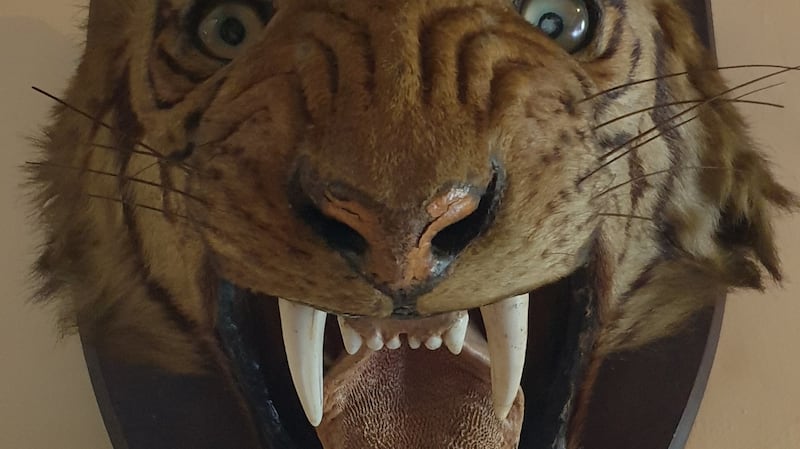The auction by Sean Eacrett of the contents of Prumplestown House takes place at Kilkea Castle golf club on June 25th. Viewings of the 700 lots included in the sale will be held at Prumplestown House from June 22nd to June 24th, and until noon on the day of the sale.
For the landed elite in 18th century Ireland, there was no nobler sport than that of hunting, and every big house worthy of its name had stables and land for the activity.
For the more affluent a hunting lodge was a must. Due to the vast acreage held by some members of the Anglo Irish community, it was not humanly possible to return to the big house after the hunt, which included game shooting, fox hunting, fishing and falconry. At the time Ireland supplied the nobility of western Europe with peregrine falcons and hawks, while many of the same elite would visit Ireland with their hawks to hunt.
Oscar Wilde was one of the first to publicly condemn fox hunting with the witticism in his book A Woman of no Importance that it was "the unspeakable in full pursuit of the uneatable".
Located in Castledermot, Co Kildare, Prumplestown House is a rambling 19th century hunting lodge on 298 acres. The property, which recently sold in four lots totalling €4.8 million, served originally as a hunting lodge for the Dukes of Leinster.
Part of the house is said to be subsumed into an older building dating from the 17th century. Coincidentally, the location for the sale at the golf club of Kilkea Castle is apt as the FitzGeralds, who were the Dukes of Leinster, gained ownership of the castle in 1180.
Legend has it that the family coat of arms derives from an incident during a fire at yet another of the FitzGerald estates – Woodstock Castle – in which a monkey rescued the then infant John FitzGerald, and the first Earl of Kildare and Duke of Leinster. The family crest features a monkey in testament to the incident.
Cattle breeders
Prumplestown House was purchased by the Wright family in 1897, who ran the estate as a farm, and are attributed with the introduction of the Simmental cattle breed to Ireland.
The family were also noted breeders of Shorthorn cattle, and this is evidenced in the many silver medals (the top accolade) from the RDS which feature in the auction catalogue. Seventeen sets of medals, all of which are solid Irish silver, are listed at prices between €180 and €220.

Along with an extensive list of furniture, including some important Regency pieces, are custom-made items for the Duke of Leinster by his personal carpenter. The pieces are made from local oak, include a triple hall seat, carved hall chair, sideboard, dining table and chairs, and were reputed to be crafted especially for Prumplestown.
Also featured are paintings by Maurice Wilks and Douglas Alexander. Three of these depict Ballynahinch in Connemara, and are priced at between €300 and €500, and €1,500 to €2,000 respectively.
Ballynahinch Estate, now a country house hotel, was also a former hunting lodge for Prince Ranji, maharajah of Nawanger, India. He spent 10 summers in Ballynahinch fishing for trout and salmon after throwing in his cap as a cricket champion.
At one stage it was one of the largest estates in Britain and Ireland, and is said to have had the longest driveway in the world at 41 miles. It was home to Richard Martin, or "Humanity Dick", a title bestowed on him by King George IV.
He succeeded in the passing the Cruel Treatment of Cattle Act into British law in 1822, and was also the founder of the Society for the Prevention of Cruelty to Animals in the early 1800s. Were he still around he would no doubt have something to say about the pair of mounted tiger heads included in the Prumplestown sale.
Silver trophy cup
Also in the auction, but not part of the Prumplestown House collection, is the Peard Cup; the Phoenix Park races silver trophy cup made by West and Son in Dublin in 1911. It is named after JHH Peard, founder of the former Phoenix Park racecourse, whose descendants ran the racecourse until it closed in 1981. Accompanying the trophy is a photograph of King George V presenting it to Mrs Peard at the Phoenix Park in 1911.
While the auction features many agricultural and hunting memorabilia, it also offers much in the way of other curiosities such as vintage playing cards and card tables, bowler hats and a large selection of glass, including cranberry crystal – coloured glass whereby gold is added to create a ruby colour, which was much cherished by the Victorians.
See seaneacrettantiques.ie











